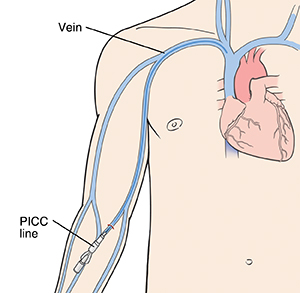PICC stands for peripherally inserted central catheter. This is a short-term (temporary) tube that's used instead of a regular I.V. (intravenous) line.
Reasons for using a PICC line
A PICC line may be used because:
-
It reduces the discomfort of putting in a new I.V. every time it's needed.
-
Medicine or nutrition needs to be given over a period of weeks or even months.
-
A PICC can stay in place longer than an I.V., so it reduces needle sticks.
-
It reduces damage to small veins, where an I.V. is normally inserted. This can allow some substances that damage small veins to be infused safely and comfortably.
-
A PICC may have more than one channel, so different fluids or medicines can be given at the same time.
-
A PICC line allows for home therapy.
Your PICC will need some care to keep it clean and working. This care includes:
-
Changing the bandage (dressing).
-
Flushing the catheter with fluids.
-
Changing the cap on the end of the catheter.
A nurse or other health care provider will teach you how to do each of these things. If you have any questions, contact your care team.
Home care
The following are general care guidelines that will help you care for your PICC line at home:
-
You can use your arm. But stay away from any activity that causes pain.
-
Don't pick at it or pull on the tubing.
-
Don’t lift anything heavier than 10 pounds with the arm on the side of the PICC line.
-
The PICC line and dressing should not get wet. When you bathe or shower, tape plastic wrap over the site to keep it dry.
-
Don't put the PICC site under water. No swimming or hot tubs. If the dressing gets wet, change it right away if you've been trained to do so. If not, contact your care team.
-
Always wash your hands with soap and clean, running water before and after touching any part of your PICC.
-
Don't allow the tubing to hang freely. Make sure to keep the tubing covered and secured to your arm to prevent the PICC line from being pulled out by accident.
-
Don’t use any sharp or pointy objects around the catheter. This includes scissors, pins, knives, and razors.
The following tips will help you with dressing changes:
-
Change the dressing over the site as directed. This is usually once a week. Change it sooner if the dressing gets wet or soiled. Check the dressing daily.
-
You or a family member may be able to do the dressing change at home. Or you may be instructed to return to the office or clinic for dressing changes.
-
Sterile technique must be used for PICC dressing change. If your dressing is changed at home, be sure you or your family member knows the sterile dressing technique. Contact your health care provider for instructions if you need them.
Follow-up care
Follow up as advised by your health care provider.
When to get medical care
Contact your health care provider right away if any of these occur:
-
Fever of 100.4°F (38°C) or higher, or as advised by your provider
-
Drainage from the PICC site
-
Swelling or bulging around the PICC site, or anywhere above the insertion site
-
Bleeding from the PICC site
-
Skin pulling away from the PICC site
-
Redness, warmth, or pus at the PICC site
-
Tubing breaks, splits, or leaks
-
More exposed tubing (tubing seems longer), or the tubing is pulled out completely
-
Medicine or fluids don't drain from the bag into your PICC
-
Coughing, wheezing, or shortness of breath
-
A racing or irregular heartbeat
-
Muscle stiffness or trouble moving the arm



